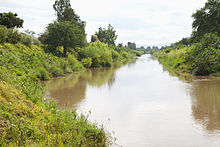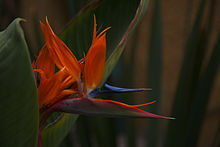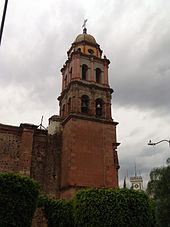Ameca (Jalisco)
| Ameca | ||
|---|---|---|
|
Coordinates: 20 ° 33 ′ N , 104 ° 3 ′ W Ameca on the map of Jalisco
|
||
| Basic data | ||
| Country | Mexico | |
| State | Jalisco | |
| Municipio | Ameca | |
| Residents | 36,156 (2010) | |
| - in the metropolitan area | 57,340 | |
| City insignia | ||
| Detailed data | ||
| City Presidency | Margarito Pachecho Oliva | |
| Website | ||
Ameca is a city in the Mexican state of Jalisco . It is the administrative seat and economic center of the municipality of the same name Ameca and is located at 1,235 m above sea level, in the south of the Ameca valley. The whole year there is a warm to hot climate. The population works mainly in trade, agriculture and livestock farming, especially in sugar cane cultivation , but also in grain cultivation and in cattle , pig and horse breeding. Other branches of industry are beekeeping, poultry farming and forestry.
Its proximity to the urban area of Guadalajara and the abundance of water, flat terrain and fertile soil have made Ameca a preferred location for economic activity in recent years. In 2010 the construction of a new industrial park began.
history
The first primitive settlement was carried out by the indigenous Jojouhquitecuani ("The brave lion"), who was a very feared person and came to the land around 1325 with a large number of people, which was fertile, with good earth, hills and good for him the hunt appeared. He conquered other villages that were under the control of the Cazonci . Jojouhquitecuani, however, knew how to prevent this with his enormous bravery.
It is not known exactly how long Jojouhquitecuani ruled, but his children, grandchildren and great-grandchildren followed him into office until the arrival of the Spaniards.
The first Spanish conqueror to reach Ameca was the soldier Juan de Añesta in 1522, who arrived without socks, alone and with his sword in hand. The aborigines received him in peace because they thought he was the son of the sun; their ancestors had already foretold the arrival of the conqueror, their subjugation and tribute.
Juan de Añesta came to Colima first with Cristóbal de Olid ; he lived in Ameca for 4–5 years, after which he returned to Colima as a representative of Ameca, where he later died.
In 1529 , together with other monks and Spaniards , Fray Antonio de Cuéllar built an air-brick chapel, the royal house, the main square, a prison, an inn and other houses, which today form the center of the city.
In 1541 Fray Antonio de Cuéllar began to catechize the natives, he died on August 12 of the same year in Ameca, just as the great uprising against the Spaniards was just beginning to break away. He was attacked in the Etzatlán Valley and died from an arrow wound.
In 1549 Ameca was elevated to a village with its own mayor within the territory of the Viceroyalty of New Spain . There have been many political changes in the region; Ameca was first part of Colima, later Mexico City , Sayula and Cocula .
In 1824 it was incorporated into the Cocula district, which was given the title of small town in September 1830.
On April 22, 1833 , Ameca was declared a city by a decree of the state Congress.
On August 28, 1979 , Ameca celebrated its 450th anniversary, a festival was celebrated at which representatives of the three branches of the state were also present.
Culture and sights
nature
In terms of nature there is the Río Ameca and other smaller bodies of water such as El Palmerejo and Los Pilares, which are designed as baths; the hills of Ameca and La Tilla can be climbed.
Theaters and museums
Ameca is part of the cultural heritage of Jalisco, which can be admired, for example, in the exhibitions of the House of Culture, which is located in Jardín Juárez, as well as in the cultural center HRG, which was specially created to refresh the local culture.
Buildings
District Palace
The district palace is dated to 1529, but fell victim to the fire in 1914 and was rebuilt in neoclassical style between 1917 and 1924 . It is laid out on two floors, on the right side (seen from the main square) it has a square tower with clocks on each side, framed by a battlement .
House of Culture
In this room plastic art and historical objects are exhibited, but also music and dance events are held. Alongside the cultural August, an exhibition of fine arts, it has built a reputation over the years. It houses the Regional Museum of Ameca, and although it is very small, it makes a valuable contribution with its historical, archaeological and paleontological objects of more than 10,000 pieces. The preservation of this material was carried out by Professor Filemón Gutiérrez Ramírez, who for 50 years Pieces collected from the regions of the Ameca Valley, Quitupan, Tala and other areas of the country (Nayarit, Veracruz y Zacatecas ). In 1982 he donated his collection in order to found a museum with the help of the town hall.
Cultural, regional center HRG
Dated to the end of the 19th century, donated by Mr. Hilarión Romero Gil, whose name it also bears, it was initially built as a hospital, but used as a military quarters for several years, then abandoned. Today, after it has been renovated, it houses the city's museum, with spacious and pleasant halls, which provide a beautiful setting for historical and prehistoric pieces. It has already been used for recording music videos, theater performances and various exhibitions.
Church of the Apostle Santiago (Santiago Apóstol)
Built in the 16th century, it underwent various changes by 1930 ; its facade is made of pink quarry and it has a tower of 3 bodies, there is a cross on the altar with depictions of the Passion of Christ, with inscription from 1687 ; Inside the temple, the main altarpiece stands out, which is in the neoclassical style. The atrium was recently restored and appears in a new light with spacious garden areas that contain roses and other flowers. The Church of Santiago Apóstol is located in the main square and is one of the most beautiful buildings in the city.
The great lord of Ameca
The great Lord of Ameca (Señor grande de Ameca) is a sculpture of the crucified Christ, which was formed with a corn paste and by the hand of natives a few centuries ago, it is almost 2 meters high. With her body and face full of bloody wounds and her side open, she is in a niche in the main altarpiece of the Church of Santiago Apóstol de Ameca. The feast of the Lord of Ameca is mobile and takes place between the months of April and May and lasts for 10 days.
Church of the Virgin Mary (Santuario de la Virgen de Guadalupe)
It dates back to 1875 . Its front is formed by a body and two towers, which show columns made of rubble.
Chapel of the Shell (Capilla de la Conchita)
Erected in the 19th century, it has a forecourt with a portico on the front and an organ inside.
Haciendas
The main haciendas of the area are located in El Cabezón, San Antonio Matute, La Esperanza, El Portezuelo, El Cuis, Santa María de la Huerta, Jayamitla, La Higuera, San Miguel, San Nicolás, La Villita, La Labor de Solís, La Labor de San Ignacio, La Gavilana and San Juan de los Arcos. Some of them are in ruins, others are partially destroyed and a few have been restored.
Sports
A high-class sports center was recently built in Ameca, offering space for a wide variety of sports, such as an Olympic swimming pool. There is also the “Cazcanes de Ameca” unit of the Sports and Events Authority (Núcleo Deportivo y de Espectáculos). In this there is a football stadium with space for about 10,000 spectators, a football school, fitness studio etc. In this stadium the football games of the local team "Cazcanes de Ameca", which is currently in the third division, are played.
For sports and recreation, Ameca offers two sports centers, the Liberación y la Manuel H. Gómez Cueva sports center, which offers soccer fields, indoor soccer, an Olympic track, basketball fields, relaxing games, terraces for family outings, drinking fountains and much more. There are several parks in the city, including Morelos Park, which is located on the riverside and is part of the “River, your space” environmental project.
Regular events
Popular festivals : The Señor Grande de Ameca festival, in the parish of Apóstol Santiago, is mobile and takes place between April and May and lasts 10 days.
Feast of the Church of Guadalupe , which is held in the church of the same name on December 12th.
Feasts of St. Joseph , which are celebrated for 9 days in the church of the same name and begin on March 19th.
Feasts of the Fatherland take place in September.
Feasts of the Virgin of Candelaria take place in the El Cabezón estate on February 2nd. The feasts of St. Anthony are celebrated in the hacienda of San Antonio Matute on June 13th and the feasts of La Asunción are held in the haciendas of La Esperanza and Santa María de la Huerta on August 15th.
Carnival takes place for 10 days before "Carnival Tuesday"; it begins on Saturday with "burying the bad mood" and a costume contest; Every day there are rodeos, horse races, cockfights, serenades, folk dances, as well as cultural and sporting events. Most of the events take place in the exhibition area in the north of the city.
The solemnity of August cultural devotes a whole month to activities and events related to all areas of the fine arts. Because of this event, Ameca describes itself as the cultural capital of the Valles region.
Celebrations of the Virgin of Hope are held in the second week of August in front of the hacienda of la Esperanza, a village that is now part of Ameca.
Customs and Traditions
- Legends : After the cult of the god Teotl, it is said that their prisoners grew fat for 40–50 days, after which the chief went to Tocalli to thank Teotl. They fasted for 5 days, after which they had the fat prisoners brought, laid them on their backs, opening their chests to tear out their hearts, which they offered Teotl while still beating. Then they threw the dead bodies to the natives to eat, and they held dances in honor of Teotl, so that he would always protect them and they would always be victorious.
- The legend of Chavarin tells of a monster half snake, half human who lives in the Ameca river. The legend of "All or Nothing" tells the story of two friends who found a hidden cave full of gold in the hill "Los tres picachos".
- Handicrafts : saddle and sandals.
- Typical clothing : the traditional costume of the farmers
Culinary specialties
Typical dishes are pozole, enchiladas , tacos , chilayo (red soup with pieces of beef) and tamales . Typical drinks for Ameca are tequila and sugar cane juice. The "Picón", a bread made from white or wholemeal flour, with sultanas and nutmeg, which has an unmistakable taste, is also very popular.
economy
Companies
Many residents work in trade and agriculture. The economically most important companies are the sugar refinery, the Coca-Cola distribution center , the feed industry and other established companies that have gradually settled in the district. There are also brick-making companies, tortilla bakeries, carpenters, bakeries and saddle makers.
Large distribution centers
In Ameca there are distribution centers of various national and international companies such as:
- Coca-Cola bottler CeDis Ameca.
- Distribution center of Lala (dairy products)
- Cuauhtémoc Moctezuma Brewery .
Trade and supply
There are 570 food stores, 103 butcher shops and 98 fresh fruit and vegetable stores for the supply.
There are four public markets, a market hall, a shop for commercial needs, two LICONSA milk distribution points, a permanent market, a weekly market and a flea market.
Ameca also offers self-service stores from national and international retail chains such as: Bodega Aurrerá , Soriana, Oxxo , Farmacias Guadalajara , Coppel, Elektra , Muebles America , El Bodegón . Banks represented are BanBajio , Banorte , Scotiabank , HSBC , BBVA Bancomer , Banamex , Banco Azteca .
The city also offers favorable conditions for smaller businesses.
Personalities
- José Salazar López (1910-1991). Cardinal, Archbishop of the Diocese of Guadalajara.
sons and daughters of the town
- Joaquín Pérez (19360–2011), show jumper
Individual evidence
- ↑ Self-presentation of the community of Ameca, first section ( Memento of the original from June 11, 2013 in the Internet Archive ) Info: The archive link was automatically inserted and not yet checked. Please check the original and archive link according to the instructions and then remove this notice.
- ↑ Self-presentation of the community of Ameca, section Historia ( Memento of the original from June 11, 2013 in the Internet Archive ) Info: The archive link was inserted automatically and has not yet been checked. Please check the original and archive link according to the instructions and then remove this notice.
- ↑ Self-presentation of the community of Ameca, section Personajes Ilustres ( Memento of the original of June 11, 2013 in the Internet Archive ) Info: The archive link has been inserted automatically and has not yet been checked. Please check the original and archive link according to the instructions and then remove this notice.
Web links
- Enciclopedia de los Municipios y Delegaciones de México: Ameca (Spanish)
- jalisco.gob.mx: Ameca (Spanish)
- Ameca administration website
- Ameca tourist guide (in Spanish) (PDF; 812 kB)










